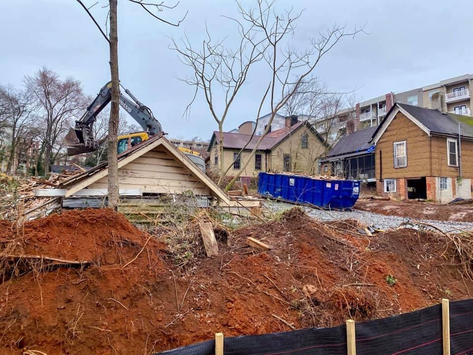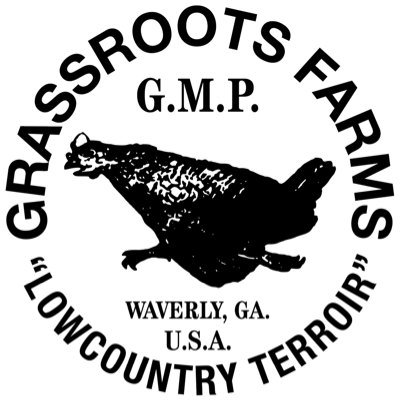 Apartment buildings loom over the destruction of a historic neighborhood. Photo by Tommy Valentine Apartment buildings loom over the destruction of a historic neighborhood. Photo by Tommy Valentine Sam Burnham, Curator It is hard to imagine a more savage and barbaric scene than a track hoe run amok in a historic neighborhood. A dragon with mechanical locomotion and hydraulic jaws ripping timeless craftsmanship to shreds with ease evokes the axiom that great things are difficult to create but can be destroyed in moments. Like the Fourth Beast in the Book of Daniel, nothing beautiful, nothing peaceful, nothing idyllic can survive the onslaught of those iron jaws. Nothing but rubble can remain. That is precisely what has happened in Athens in recent weeks. The historic Potterytown neighborhood fell under the elongated shadow of progress. Several single family homes were obliterated to make room for a parking deck for the rising tide of apartment buildings. Such development is common in college towns. The market for rental property is quite lucrative. The buildings that come down always seem to have more character and style than the buildings that go up. It’s important that we keep a proper perspective. The crews doing this work aren’t evil. They’re just doing an honest day’s work. In this economy, who can blame them? The machines aren’t evil. They’re simply tools that can be used to build just as they can be used to mangle. Even the developers can’t be labeled as anathema as they are just following the market pressure they have been taught to follow. Private property is essential. I dislike the idea of restricting the markets or curtailing the liberty of property owners. The problem is that we have dumbed down the market to its lowest denominator: money. The market is controlled by people who know the price of everything but the value of nothing. Every decision is strictly financial. Other important considerations such as history, culture, style, and local uniqueness don’t factor in. That’s an incomplete market. In my youth I would cringe ever so slightly as Kevn Kinney sang the line “like tearing up your parking lot to build a house, so you’ll just have to park your Volvo somewhere else.” It seemed so unrealistic, even anti-market. Examination and experience have taught me how wrong I was. We shouldn’t pave the entire world just because it’s profitable. We have to live somewhere, eat something, and appreciate our surroundings sometimes. A parking deck accomplishes practically none of this. When a plea is made for historic preservation there is a common reaction from those beguiled by “progress.” Preservation action is seen as do-gooders trying to prop up some dilapidated building. Time moves on and so should we. You must clear out the old to make room for the new. Unsubstantiated claims of obsolescence can have an appeal to the general public despite the examples of brilliant use of historic properties such as Atlanta's Ponce City Market and Canton's Cotton Mill Exchange. In Canton alone, several historic structures from the textile industry have been converted to commercial and residential use. It’s a wiser and more effective use of resources. The truth is preserving historic buildings can be quite profitable as the above examples prove. Historic buildings can offer sturdier, more durable construction than many lightweight construction options. Older architecture offers features and details that don't fit modern budgets. We also maintain a diversity of styles and techniques by preserving existing buildings.
When it comes to a neighborhood like Potterytown in Athens, preservation could have maintained single-family residential units with actual yards, mature trees, small scale landscaping, privacy, and a multitude of other benefits that are sacrificed in the communal living of an apartment building. Good fences make good neighbors. The ceiling/floor of an apartment seems to have a different effect.. But neighborhoods also protect the identity of a town like Athens. The Classic City is famous for the university but also for its quirky and eccentric style that gave rise to the music and art that made the town a household name. A tree that owns itself. An abandoned train trestle. Weaver D's. A double-barreled cannon. And until last week, Potterytown. Some of that uniqueness is gone forever. In its place we get some concrete superstructure, some rebar, and of course, dormant Volvos. What would be wrong in tearing down an old rundown strip mall or some other eyesore for this purpose? Preserving historic property isn't propping up dilapidated buildings. It is preserving our story. It is preserving our heritage. It is preserving our very identities. Preservation is the work that will keep our entire existence from becoming just another off ramp off just another highway - generic, nameless, faceless, nondescript. We’ve seen this happening across Metro Atlanta for decades now. Formerly small distinct towns have redeveloped to the point they look just like all their neighbors. Apartment buildings. Gas stations. Bradford pears. Cookie cutter commercial buildings. It comes down to the words of Sir Roger Scruton: "...good things are easily destroyed but not easily created." It took a century for Potterytown to become what it was. It took a few days to become what it now is. And now, it will never be what it could have been. It’s has been lost to time and “progress.” What piece of our culture and identity will we lose next?
0 Comments
Leave a Reply. |
Sam B.Historian, self-proclaimed gentleman, agrarian-at-heart, & curator extraordinaire Social MediaCategories
All
Archives
November 2022
|




 RSS Feed
RSS Feed
